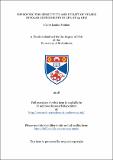Files in this item
Improving the sensitivity and utility of pulsed dipolar experiments in EPR at 94 GHz
Item metadata
| dc.contributor.advisor | Smith, Graham Murray | |
| dc.contributor.author | Motion, Claire Louise | |
| dc.coverage.spatial | xxxi, [3], 185, [8] p. | en_US |
| dc.date.accessioned | 2018-06-12T14:50:08Z | |
| dc.date.available | 2018-06-12T14:50:08Z | |
| dc.date.issued | 2018-06-27 | |
| dc.identifier.uri | https://hdl.handle.net/10023/13969 | |
| dc.description.abstract | Pulsed dipolar spectroscopy (PDS) is an electron paramagnetic resonance (EPR) technique, used to conduct long range distance measurements in proteins in the nanometre range. This thesis presents a number of methodological and instrumental techniques to improve the sensitivity and utility of PDS experiments using a home-built high power pulsed spectrometer, HiPER, operating at 94 GHz. These include the implementation of phase-modulated composite pulses, which correct for imperfections arising due to inhomogeneity, and offer increased excitation bandwidth as well as experimental protocols such as annealing and glassing of samples. A theoretical study into the use of matched filtering to reduce echo noise during measurements, has predicted gains of up to a factor of 3 enhancement in signal-to-noise. Using such techniques we demonstrate sensitivity enhancements of more than 30 on PDS experiments, between nitroxides and Fe centres, in haem-proteins, corresponding to a reduction in averaging time of almost 1,000, in comparison to standard commercial spectrometers operating at X-band. The use of composite pulses in PDS experiments on nitroxide biradicals were also investigated, including their limitations due to intramolecular effects. The thesis then describes a single frequency dipolar modulation experiment, RIDME, and uses high field measurements to determine both the distance and relative orientation of a cobalt-nitroxide system, for the first time. Finally, a design study is conducted to implement frequency and amplitude modulated pulses on a spectrometer at 9/34 GHz to improve sensitivity. | en |
| dc.language.iso | en | en_US |
| dc.publisher | University of St Andrews | |
| dc.subject | Electron paramagnetic resonance | en |
| dc.subject | Pulsed dipolar spectroscopy | en |
| dc.subject | Instrumentation | en |
| dc.subject | Magnetic resonance | en |
| dc.subject.lcsh | Electron paramagnetic resonance spectroscopy | en |
| dc.title | Improving the sensitivity and utility of pulsed dipolar experiments in EPR at 94 GHz | en_US |
| dc.type | Thesis | en_US |
| dc.contributor.sponsor | Engineering and Physical Sciences Research Council (EPSRC) | en_US |
| dc.type.qualificationlevel | Doctoral | en_US |
| dc.type.qualificationname | PhD Doctor of Philosophy | en_US |
| dc.publisher.institution | The University of St Andrews | en_US |
This item appears in the following Collection(s)
Items in the St Andrews Research Repository are protected by copyright, with all rights reserved, unless otherwise indicated.

